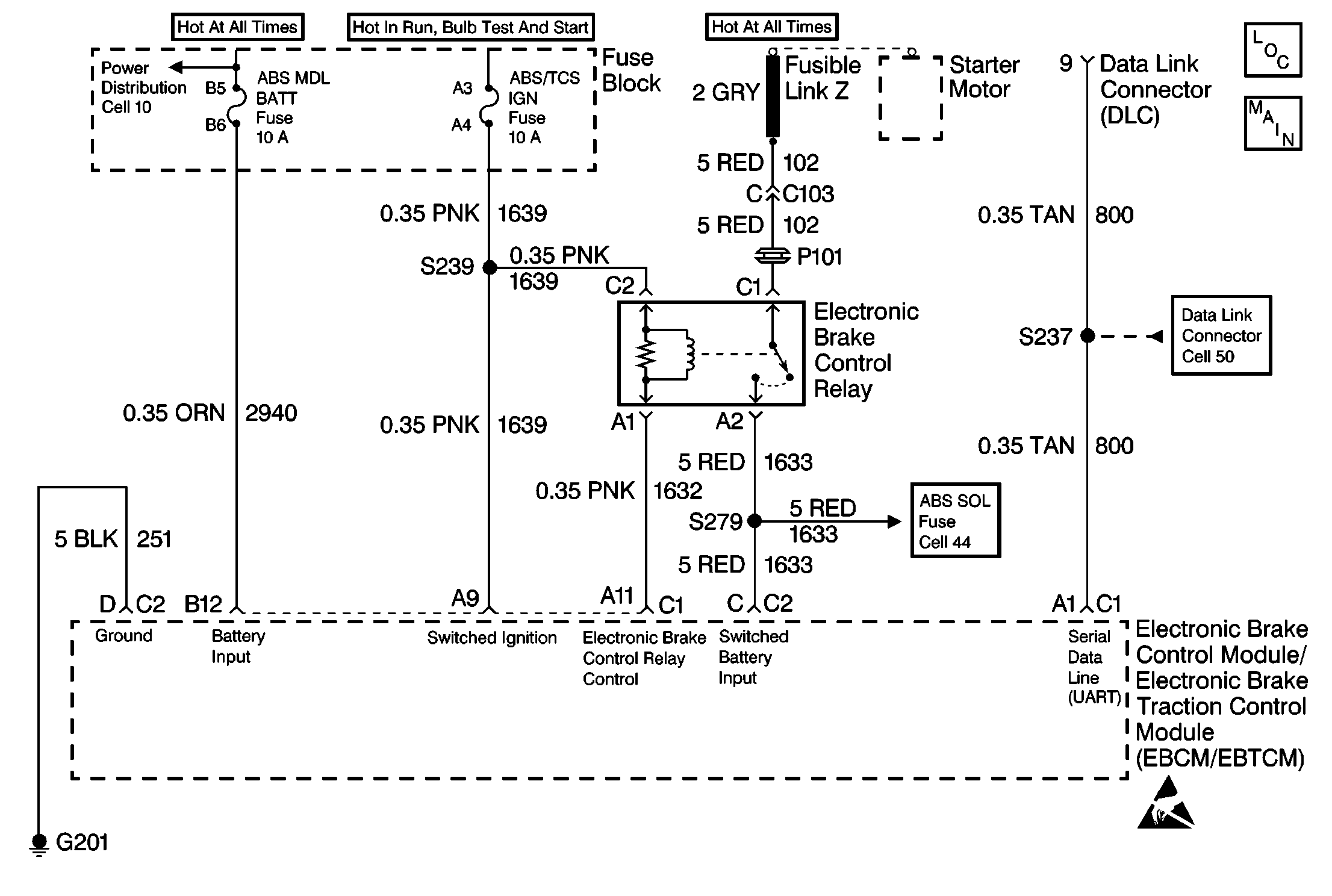
Circuit Description
Ignition voltage is supplied to terminal C2 of the Electronic Brake Control Relay. The above condition enables the EBCM/EBTCM to energize the pullin coil by completing the ground circuit at connector C1 terminal A11 of the EBCM/EBTCM. The magnetic field created closes the Electronic Brake Control Relay contacts. The magnetic field also allows battery voltage and current through the Electronic Brake Control Relay terminal C1 to be supplied to the EBCM/EBTCM through connector C2 terminal C and to the Brake Solenoid Valves through S279.
Conditions for Setting the DTC
DTC C1214 can set anytime after the EBCM/EBTCM commands the Electronic Brake Control Relay on. The command occurs during the three second bulb check.
DTC C1214 monitors the availability of current/voltage to the motors and solenoids.
The above malfunction indicates voltage is not available. The malfunction will not allow ABS/TCS operation.
Action Taken When the DTC Sets
| • | A malfunction DTC stores. |
| • | The ABS/TCS disables. |
| • | The amber ABS/TCS warning indicators turn on. |
| • | The red BRAKE warning indicator turns on if the rear piston in the ABS brake motor pack is not in the home position. |
Conditions for Clearing the DTC
| • | The condition responsible for setting the DTC no longer exists and the Scan Tool Clear DTC function is used. |
| • | 100 drive cycles pass with no DTC detected. |
Diagnostic Aids
The following conditions may cause an intermittent malfunction:
| • | A poor connection |
| • | Rubbed-through wire insulation |
| • | A broken wire inside the insulation |
Use the enhanced diagnostic function of the Scan Tool in order to measure the frequency of the malfunction. Refer to the Scan Tool manual or Scan Tool Diagnostics located in this section for the procedure.
Thoroughly inspect any circuitry that may be causing the intermittent complaint for the following conditions:
| • | Backed out terminals |
| • | Improper mating |
| • | Broken locks |
| • | Improperly formed or damaged terminals |
| • | Poor terminal-to-wiring connections |
| • | Physical damage to the wiring harness |
Vibration and Temperature Effects
| • | Use the following procedure in order to inspect for vibration effects by performing the Relay Test function of the Scan Tool: |
| 1. | With the Relay Test commanded on lightly tap the top and sides of the Electronic Brake Control Relay while monitoring the Electronic Brake Control Relay voltage. |
| 2. | If the Electronic Brake Control Relay voltage changes significantly replace the Electronic Brake Control Relay. |
| • | If DTC C1214 only sets when the vehicle is initially started in cold ambient conditions (temperature less than 0°C - 32°F) replace the Electronic Brake Control Relay. |
Important: Zero the J 39200 test leads before making any resistance measurements.
Step | Action | Value(s) | Yes | No |
|---|---|---|---|---|
1 | Was the Diagnostic System Check performed? | -- | Go to Step 2 | Go to Diagnostic System Check |
2 |
Is DTC C1216 present (either as a current DTC or a history DTC)? | -- | Go to Step 3 | |
3 |
Is the voltage equal to or greater than the specified voltage? | 10V | Go to Step 10 | Go to Step 4 |
4 |
Is the voltage equal to or greater than the specified voltage? | 10V | Go to Step 11 | Go to Step 5 |
5 |
Is the resistance within the specified range? | 0-2ohms | Go to Step 6 | Go to Step 8 |
6 | Use the J 39200 in order to measure the voltage at the electronic brake control relay harness connector terminal A1. Is the voltage within the specified range? | 10.0-14.0 V | Go to Step 7 | Go to Step 9 |
7 | Replace the Electronic Brake Control Relay. Is the repair complete? | -- | Go to Diagnostic System Check | -- |
8 | Repair the open or high resistance in CKT 1633. Is the repair complete? | -- | Go to Diagnostic System Check | -- |
9 | Repair the open or high resistance in CKT 102. Is the repair complete? | -- | Go to Diagnostic System Check | -- |
10 | The system is functioning properly at this time. The malfunction may be intermittent or is not present at the time of testing. Is a concern still present? | -- | Go to Diagnostic Aids | Go to Diagnostic System Check |
11 | Replace the EBCM/EBTCM. Is the repair complete? | -- | Go to Diagnostic System Check | -- |
